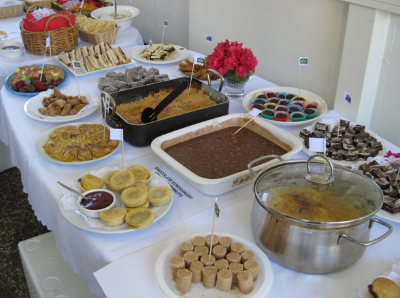Art History is studying art from around the world, from ancient times to the present day. With Art History, students cover many aspects of human history and experience. It looks at works of art not just as objects, but a way of understanding the world, and the societies in which they were created. Within Art History, students focus on the development of visual art, such as paintings, sculptures, engravings, and much more.
Art History Teacher Stacy Bailey was developing the curriculum for her AP Art History class, when she noticed that the class was divided into different cultural units. Bailey then spent many weeks diving into the history and culture of each specific region. Due to her love of trying new things and food, she started the tradition of having a celebratory food day at the end of each unit.
“I always thought it would be fun to celebrate the end of a unit of study by having a celebratory food day. So, I started that tradition about three years ago. We have six major celebratory food days that are themed around the culture and art that we have studied. Greek, Roman, and Spanish Food, Renaissance and Byzantine Food, French Food Day, American Food Day, Indigenous American and African Food Day and 6. Asian Food Day,” said Bailey.
While she introduces new units of study, Bailey slowly enters small amounts of cuisine research, allowing her students to get an idea of what they want to make, or taste, at the end of the unit. Bailey creates a sign-up, where students take ownership of the days in which they want to bring food. Every former student, and current students are invited to participate.
“They work with their parents to prepare dishes. At some point in the year, almost everyone gets to showcase something from their own culture and family, which has been such a lovely thing to see. I’ve been so thrilled at how many students from previous years continue to show up, bring food, and celebrate with us. It’s become somewhat of a legacy. It feels very familial. I love it so much,” said Bailey.
The events are significant as students get to learn about foods and cultures that are new to them. It provides them with a good sense of understanding, not by just learning about it, but getting to experience it too. Bailey appreciates the parent involvement and the way students enjoy the event.
“I believe there’s so much significance to this event. It challenges students to taste and try food they may have never had the chance to try. I can tell when families are happily sharing their culture with the class. The kids explain to each other even how to eat the dishes if it’s something many of us are unfamiliar with. One year, I had a parent who prepared an entire leg of lamb for the class,” said Bailey.
Bailey is not one who teaches for test scores, but a teacher who thinks it’s important that students imagine and experience the information they are taking in. Along with these events, Bailey shares photos and stories from her own personal experiences, and uses her love of food and art to continue to travel and make memories that she teaches, hoping to inspire her students to explore the world too.
“I think it’s important for students to be able to imagine how they can actually use the information I teach in their real and actual lives. I hope that as my kids remain curious about different cultures and create a life where they can actually go experience things for themselves. In the meantime, I will do everything I can to bring those cultures to them here. Food is one of the best ways to get to know a culture. I’m so thrilled that the kids have taken such ownership over these celebrations. I’ve gotten to eat so many dishes I would have never gotten to try,” said Bailey.
Beyond the cultural learning, Bailey continues to highlight the importance of Art History, including why it’s important to experience and take in the information the world has to offer. These events have evolved into something hundreds of students, teachers, and parents have enjoyed, allowing them to experience new cultures, while also sharing their own.

